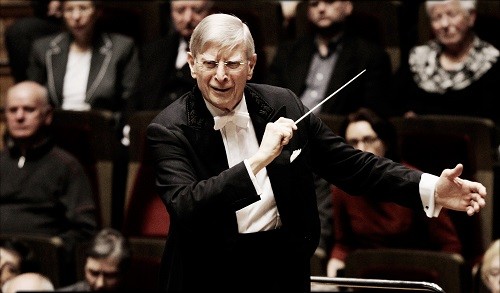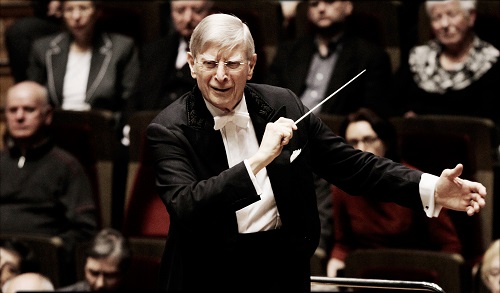 United Kingdom Brahms, Beethoven: Martin Helmchen (piano), Philharmonia Orchestra / Herbert Blomstedt (conductor), Marlowe Theatre, Canterbury, 28.5.2017. (CS)
United Kingdom Brahms, Beethoven: Martin Helmchen (piano), Philharmonia Orchestra / Herbert Blomstedt (conductor), Marlowe Theatre, Canterbury, 28.5.2017. (CS)

Brahms – Piano Concerto No.1 in D minor Op.15
Beethoven – Symphony No.7 in A Op.92
We all hope for happy and healthy longevity but how many of us can imagine sustaining a career as a professional conductor into our nineties? Herbert Blomstedt’s 90th birthday is just a few weeks away but he is doing just that. More astonishingly, during this concert with the Philharmonia Orchestra at the Marlowe Theatre Canterbury, Blomstedt conducted Beethoven’s Seventh Symphony from memory, creating a performance of freshness and vitality which gave deep and obvious pleasure to the performers and audience alike.
Blomstedt’s conducting style is idiosyncratic but suggests absolute knowledge, conviction and sureness. Paradoxically, while his feet are firmly planted on the low podium and his back is as straight as a ramrod, he sways and swivels from the hip upwards, physically communicating the expressive sentiment and meaning of the music with an understanding borne of decades of learning, performing, reflecting and revisiting. He generates astonishing vigour: his elbows jerk back at an alarming angle, his arms swing left then right then around – it’s just as well that Blomstedt dispenses with a baton or I dread to think where it might fly if it were to slip from his grasp. Every section of the orchestra is drawn into the whole sound world, encouraged and guided by coaxing hands and lively facial gestures. In this performance, Beethoven’s grandeur and grace were tended with equal mastery: I was astonished by the expressive range and by the way changes between diverse moods were effected so rapidly but so naturally. Just at the moment when Blomstedt’s vigorous gestures seemed to be searching for ever more magisterial power, so the arms would fall, the hands draw in, and a woodwind soloist or instrumental section would be picked out by a pertinent flick of the fingers and nurturing gaze, taking us as if by magic from grandeur to refinement.
The Poco sostenuto introduction announced its grandiose ambitions and intent through the crescendo-ing rising scales triggered by the weighty chordal kick-starts; the repeating semiquavers acquired an irresistible momentum that propelled us into the skipping brightness of the Vivace but, more than that, seemed to serve as a signpost pointing unwaveringly towards the symphony’s final bars. Blomstedt left us in no doubt that it is rhythm that drives this symphony; indeed, several moments followed on segue, as if part of a single continuum – but the shift between major/minor (as when moving between the first and second movements) could be disquieting.
I don’t think I’ve heard the strings of the Philharmonia play so well here at the Marlowe Theatre; it’s not the easiest of venues for string sections to negotiate (see below and previous reviews), but there was real power, precision and consensus here and throughout the symphony. I wondered if Blomstedt’s preferred antiphonal violin-section placing had anything to do with the renewed vitality of the strings, for the second violins seemed to command the conductor’s attention equally with the firsts, and the double basses – nestling behind the cellos and back-desk firsts – swelled with substantial force: underpinning, propelling and energising.
The Allegretto had a beautiful grace; this was, initially, a dignified dance, but there was no lessening of tension as the material was transformed through multiple permutations, from lilting ease to dramatic rhetoric. When one thinks that it’s all basically scales and arpeggios, Beethoven’s (and Blomstedt’s) expressive range and impact is astonishing. Some of the dynamic and harmonic contrasts were quite unsettling, as when, in the closing bars, the slide towards an unexpected C major was complemented with a fortissimo pronouncement which shattered the preceding pianissimo calm, before more ‘reassuring’ A minor footholds were found.
There’s an anecdote – I can’t remember where I read it, years ago – about someone being stopped on a US highway for speeding and using the Presto of Beethoven’s Seventh as an excuse for their impetuosity. The decorated major third motif was thrown through the strings with reckless abandon and flawless precision to be answered by the wind’s quelling delicacy; how did Blomstedt conjure such drama and range in so few bars? There was some lovely playing from the horns and woodwind (especially the clarinets) in the Assai meno presto sections but the episodes offered only momentary ‘rest’: the ‘outbursts’ of fortissimo ‘rage’ were quite shockingly violent at times, even though the polish of the playing was ever apparent. In the Allegro con brio finale there was a breathlessness and an optimism which was as evident in the players’ smiles as in their playing.
Though he was partially obscured from my view by the raised lid of the centre-stage Steinway – which reflected a beautiful, gleaming image of the grand’s interior – Blomstedt was a more restrained guide in the first half of the concert, in which the Philharmonia were joined by the young German pianist Martin Helmchen for a performance of Brahms’ First Piano Concerto. Here Blomstedt seemed primarily concerned that the Philharmonia should provide sympathetic, proficient support – which they did.
At the start of the lengthy Maestoso, though, despite considerable effort to create rhythmic bite, the Philharmonia strings’ tone was hardened and dried by the Marlowe Theatre acoustic – with the timpani’s fierce roll, the effect was snarling, but there was little warmth and real depth to the tone. That said, all sections of the orchestra played with really communicative engagement throughout the concerto: the exposed horn solos in the first movement, for example, were particularly noteworthy for their eloquence, accuracy and clarity; and the cellos’ and basses’ pizzicato dancing accompaniment subsequently was buoyant and seductive.
Helmchen is no natural showman, so perhaps Brahms’ First Concerto suits him well, with its quiet, reflective entry for the soloist after a lengthy orchestra introduction and introspective slow movement. That said, Helmchen, while perhaps not plumbing the depths of Romantic ardour for this interpretation, has interesting things to say, and he distinguished effectively between simplicity and orotundity. I know some will argue that manner in which a pianist presses down the keys of a piano makes no difference to the sound produced – which is entirely determined by the mechanism – and that it is the combination of tones through which pianists shape our impression of sound, colour etc. But, still, I was convinced that Helmchen’s touch did offer differentiation, particular in the delightfully light-weight utterances of the Adagio; and in the more bombastic Romantic utterances one sensed the power coming from his lower back rather than from his fingers per se.
I never felt this performance was about ‘display’ – it was much too attentive to detail and thoughtful in intent – but at the same time I’m not sure that Helmchen communicated the full extent of the concerto’s expressive content.
The beaming smiles and animated faces of the Philharmonia players at the end of this concert were testimony to Blomstedt’s skill and magic. Indeed, he was a veritable Prospero: let us hope that he does not decide to abjure his ‘rough magic’ and ‘heavenly music’, or to ‘break my staff’ and ‘drown my book’ anytime soon.
Claire Seymour
